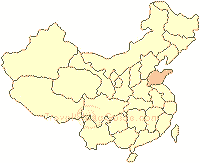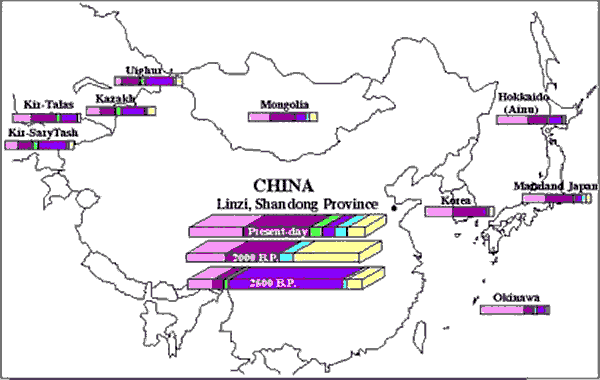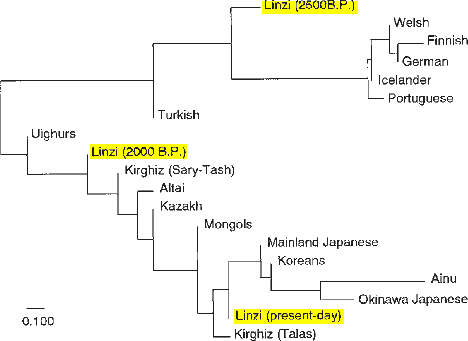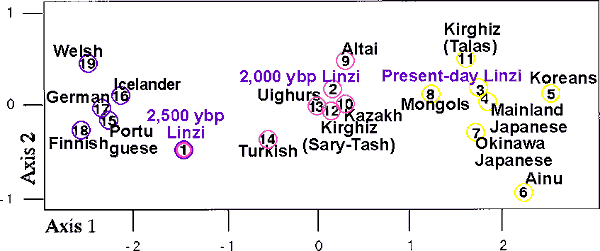Home
Contents Türkic Genetics
In Russian
Roots
Writing
Language
Religion
Geography
Archeology
Coins
Genetics: Lingo-Ethnical Tree
Ethnic Affiliation Scythians
Scythians 7 c. BC
Pazyryk 4-2 c. BC
Burial place of a Massagetan warrior 8-7 c. BC
Besenyos, Ogur and Oguz
Scythians
Alans and Ases
Kipchaks
Kipchaks in Europe
Avar Dateline
Besenyo Dateline
Bulgar Dateline
Huns Dateline
Karluk Dateline
Kipchak Dateline
Khazar Dateline
Kyrgyz Dateline
Sabir Dateline
EASTERN HUNS (or TÜRKIC) GENETICS in CHINA SHANDONG PROVINCE
Citation Excerpts
Introduction
| FIG. 3.—A neighbor-joining tree for 19 human populations. | FIG. 4.—The multidimensional scaling of 19 human populations. |
|
|
|
| Location: Shandong Province, China |  |
| Subject | Linzi Population 2,500 ybp, 2,000 ybp, and now |
| Object | mtDNA, carrying only the maternal genes |
Comparison of mitochondrial DNA (mtDNA) sequences of three populations that lived in the same location, Linzi, China, in different periods: 2,500 years ago (the Spring-Autumn era), 2,000 years ago (the Han era), and the present day. Two indices were used to compare the genetic differences: the frequency distributions of the radiating haplotype groups and the genetic distances among the populations. The results indicate that the genetic backgrounds of the three populations are distinct from each other. Inconsistent with the geographical distribution, the 2,500-year-old Linzi population showed greater genetic similarity to present-day European populations than to present-day east Asian populations. The 2,000-year-old Linzi population had features that were intermediate between the present-day European/2,500-year-old Linzi populations and the present-day east Asian populations. These relationships suggest the occurrence of drastic spatio-temporal changes in the genetic structure of Chinese people during the past 2,500 years.
Links
Genetic Structure of a 2,500-Year-Old Human Population in China and Its Spatiotemporal Changes
Li Wang, Hiroki Oota, Naruya Saitou, Feng Jin, Takayuki Matsushita, and Shintaroh Ueda
Mol Biol Evol 17(9): 1396-1400. 2000
© 2000 by the Society for
Molecular Biology and Evolution. ISSN: 0737-403
We compared the genetic structures of three populations that lived in the same location during three separate historical periods and found that the genetic structure of the inhabitants of Linzi has changed greatly over time. The period of Chinese history that dates to 2,500 years ago corresponds to the transition period from the Spring-Autumn era to the Warring States era, and the period around 2,000 years ago was in the middle of the Han era. Linzi, our sampling location, was the capital of the feudal state Qi in the Spring-Autumn and the Warring States eras. Qin, one of the feudal states during those periods, conquered other states, including Qi, and established the first unified nation in China. Subsequently, the Han dynasty followed Qin after great disturbances of war. Therefore, our finding that the population structure of Linzi changed drastically during those periods can be concordant with these historical events.
... we analyzed hypervariable region I of the mtDNA by PCR using two sets of primers that amplify the overlapping MT1 (positions 16190-16422) and MT4 (positions 16135-16366) regions.
Based on this present-day reference network, we constructed a network of the mtDNA sequences of the two ancient populations and the present-day people of Linzi (fig. 1, not shown).
Ten individuals of the 2,500-year-old Linzi population had mtDNA type with 16274A; this mtDNA type was not found in either the 2,000-year-old or the present-day Linzi populations. Sixty-five percent (22 of 34) of the individuals of the 2,500-year-old Linzi population belong to group IV, whereas none of the 2,000-year-old population and only 8% of the present-day Linzi population belong to that group.
In contrast, 38% (5 of 13) of the 2,000-year-old Linzi population belong to group VI, compared with only 9% and 10% of the 2,500-year-old and the present-day Linzi populations, respectively. The 2,000-year-old and present-day Linzi populations showed high frequencies for group I (23% and 30%, respectively) and for group II (31% and 36%, respectively). Other present-day east Asian populations, including Mongols, Koreans, and mainland Japanese, also have high frequencies for groups I and II (fig. 2).
FIG. 2.—Geographic distribution of six radiation groups in the east-central
Eurasian continent.
Radiation groups I-VI are shown from left to right.

...We also estimated the nucleotide diversity within each population and the genetic distances between the populations. We used the 172-bp mtDNA sequence data for comparison due to the lack of 13-bp data (positions 16366-16378) in the present-day European populations. The nucleotide diversities for the Linzi populations were
| 2,500-year-old | 0.020 |
| 2,000-year-old | 0.022 |
| Present-day | 0.027 |
Nucleotide diversities within the other present-day populations were similar (range 0.011-0.027). The smallest genetic distance for the present-day Linzi population was that from the Mongols, followed by those from mainland Japanese and Koreans.
Surprisingly (Sic! - Translator's Note), the three smallest genetic distances for the 2,000-year-old Linzi population were from the present-day central Asian populations: the Kirghiz (Sary-Tash), followed by the Kazakh and the Uighurs.
Even more surprisingly (Sic! - Translator's Note), the three smallest genetic distances for the 2,500-year-old Linzi population were from the Turkish, Icelander, and Finnish, rather than from the east Asian populations.
The results indicate that the genetic backgrounds of the three populations in Linzi are distinct from each other. Figure 3 shows the phylogenetic tree based on those genetic distances; present-day populations from east Asia, including the present-day Linzi population, form a cluster, which is consistent with their geographical distribution. However, the 2,000-year-old Linzi population lies outside the present-day east Asian cluster, and the 2,500-year-old Linzi population clusters with the present-day European populations.
FIG. 3.—A neighbor-joining tree for 19 human populations.
Branch
lengths are proportional to genetic distances.

The multidimensional scaling method was also applied to the genetic distance matrix data (see fig. 4). The overall constellation of the 19 populations is quite similar to that of the neighbor-joining tree of figure 3. This two-dimensional scattergram explains 96.2% of the variation, and the significant portion is already explained by horizontal axis 1. Because the present-day European populations are on the left side and the present-day east Asian populations are on the right side, this representation can be equated to the geographical map of populations, except for the two ancient populations in China.
FIG. 4.—The multidimensional scaling of 19 human populations.
Populations are designated as follows.
1: the 2,500-year-old Linzi
population; 2: the 2,000-year-old Linzi population; 3: the present-day Linzi
population; 4: mainland Japanese; 5: Koreans; 6: Ainu; 7: Okinawa Japanese; 8:
Mongols; 9: Altai; 10: Kazakh; 11: Kirghiz (Talas); 12: Kirghiz (Sary-Tash); 13:
Uighurs; 14: Turkish; 15: Portuguese; 16: Icelander; 17: German; 18: Finnish;
19: Welsh.

This strengthens the very odd (Sic! - Translator's Note) location of the 2,500-year-old Linzi population. It should be noted that the population distance analysis is based only on sequence differences within and between populations. Therefore, ambiguity of the phylogenetic relationship of mtDNA haplotypes... does not cause serious problems in the population analyses.
The similarity between the genetic structures of the 2,500-year-old Linzi population and the present-day European populations indicates that there was a genetic shift in the Linzi area from a European-like population to a population more like those found in present-day east Asia, probably caused by migration. This is in accord with the existence of the Eurasiatic superfamily languages, which surround a linguistically unique Sino-Tibetan language, the present-day Chinese language. Future molecular studies of ancient populations will help us discover the places and times of human diversification and the migration routes of ancient populations.
Footnotes
Source and Comments